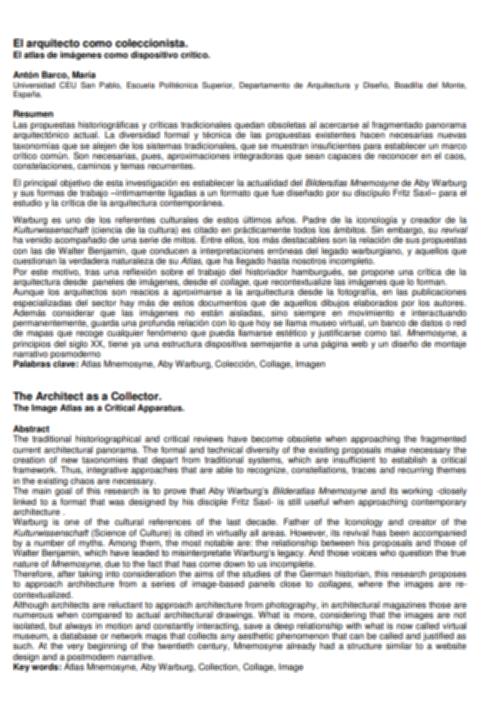Please use this identifier to cite or link to this item:
http://hdl.handle.net/10637/16332El arquitecto como coleccionista. El atlas como dispositivo crítico

See/Open:
Arquitecto_IInterConf_DesignandCriticism_2014.png
162,61 kB
image/png
See/Open:
Arquitecto_IInterConf_DesignandCriticism_2014.pdf
Restricted Access
580,4 kB
Adobe PDF
Request a copy
| Title: | El arquitecto como coleccionista. El atlas como dispositivo crítico The architect as a collector: The image atlas as a critical apparatus |
| Authors : | Antón Barco, María |
| Keywords: | Arquitectura; Diseño arquitectónico; Atlas Mnemosyne |
| Publisher: | critic|all PRESS |
| Citation: | ANTÓN BARCO, María. “El arquitecto como coleccionista. El atlas como dispositivo crítico”. I International Conference on Architectural Design & Criticism, Madrid, 2014 |
| Abstract: | Las propuestas historiográficas y críticas tradicionales quedan obsoletas al acercarse al fragmentado panorama
arquitectónico actual. La diversidad formal y técnica de las propuestas existentes hacen necesarias nuevas
taxonomías que se alejen de los sistemas tradicionales, que se muestran insuficientes para establecer un marco
crítico común. Son necesarias, pues, aproximaciones integradoras que sean capaces de reconocer en el caos,
constelaciones, caminos y temas recurrentes.
El principal objetivo de esta investigación es establecer la actualidad del Bilderatlas Mnemosyne de Aby Warburg
y sus formas de trabajo ±íntimamente ligadas a un formato que fue diseñado por su discípulo Fritz Saxl± para el
estudio y la crítica de la arquitectura contemporánea.
Warburg es uno de los referentes culturales de estos últimos años. Padre de la iconología y creador de la
Kulturwissenschaft (ciencia de la cultura) es citado en prácticamente todos los ámbitos. Sin embargo, su revival
ha venido acompañado de una serie de mitos. Entre ellos, los más destacables son la relación de sus propuestas
con las de Walter Benjamin, que conducen a interpretaciones erróneas del legado warburgiano, y aquellos que
cuestionan la verdadera naturaleza de su Atlas, que ha llegado hasta nosotros incompleto.
Por este motivo, tras una reflexión sobre el trabajo del historiador hamburgués, se propone una crítica de la
arquitectura desde paneles de imágenes, desde el collage, que recontextualize las imágenes que lo forman.
Aunque los arquitectos son reacios a aproximarse a la arquitectura desde la fotografía, en las publicaciones
especializadas del sector hay más de estos documentos que de aquellos dibujos elaborados por los autores.
Además considerar que las imágenes no están aisladas, sino siempre en movimiento e interactuando
permanentemente, guarda una profunda relación con lo que hoy se llama museo virtual, un banco de datos o red
de mapas que recoge cualquier fenómeno que pueda llamarse estético y justificarse como tal. Mnemosyne, a
principios del siglo XX, tiene ya una estructura dispositiva semejante a una página web y un diseño de montaje
narrativo posmoderno The traditional historiographical and critical reviews have become obsolete when approaching the fragmented current architectural panorama. The formal and technical diversity of the existing proposals make necessary the creation of new taxonomies that depart from traditional systems, which are insufficient to establish a critical framework. Thus, integrative approaches that are able to recognize, constellations, traces and recurring themes in the existing chaos are necessary. The main goal of this research iVWRSURYHWKDW$E\:DUEXUJ¶VBilderatlas Mnemosyne and its working -closely linked to a format that was designed by his disciple Fritz Saxl- is still useful when approaching contemporary architecture . Warburg is one of the cultural references of the last decade. Father of the Iconology and creator of the Kulturwissenschaft (Science of Culture) is cited in virtually all areas. However, its revival has been accompanied by a number of myths. Among them, the most notable are: the relationship between his proposals and those of :DOWHU%HQMDPLQ ZKLFKKDYHOHDGHGWRPLVLQWHUSUHWDWH:DUEXUJ¶VOHJDF\ $QGWKRVHYRLFHVZKRTXHVWLRQWKHWUXH nature of Mnemosyne, due to the fact that has come down to us incomplete. Therefore, after taking into consideration the aims of the studies of the German historian, this research proposes to approach architecture from a series of image-based panels close to collages, where the images are recontextualized. Although architects are reluctant to approach architecture from photography, in architectural magazines those are numerous when compared to actual architectural drawings. What is more, considering that the images are not isolated, but always in motion and constantly interacting, save a deep relationship with what is now called virtual museum, a database or network maps that collects any aesthetic phenomenon that can be called and justified as such. At the very beginning of the twentieth century, Mnemosyne already had a structure similar to a website design and a postmodern narrative |
| URI: | http://hdl.handle.net/10637/16332 |
| Rights : | http://creativecommons.org/licenses/by-nc-nd/4.0/deed.es |
| ISBN: | 9788469704240 |
| Issue Date: | 2015 |
| Center : | Universidad San Pablo-CEU |
| Appears in Collections: | Escuela de Politécnica Superior |
Items in DSpace are protected by copyright, with all rights reserved, unless otherwise indicated.

